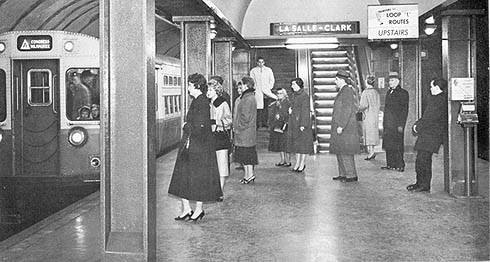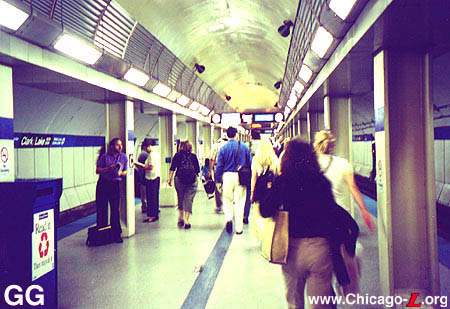
Passengers wait to board a
northbound Congress-Milwaukee "A" train of PCC
6000-series
stock near the LaSalle-Clark mezzanine at the east end of
Lake Transfer station (later renamed Clark/Lake) in late
1958. Note the transfer stamp machine on the right and the
sign telling riders they can transfer to the Loop "L"
upstairs at Clark/Lake.
For a larger view, click here.
(Photo from the Graham Garfield
Collection)
|
Clark/Lake
(100W/200N)
LaSalle Street and Lake
Street, Loop
Service
Notes:

|
Blue Line:
Milwaukee-Dearborn Subway
|

|
Accessible
Station
|

|
Transfer
Station
|

|
Owl
Service
|
Quick Facts:
|
Address:
|
124 W. Lake Street
(subway station,
Thompson Ctr/203 N. LaSalle entrance)
|
|
191 N. Wells Street
(Wells/Lake
entrance)
|
Established: February 25, 1951
Original Line: Milwaukee-Dearborn Subway
Previous Names: Lake Transfer
|
Skip-Stop Type:
|

|
Station
|
Rebuilt: 1986-96
Status: In Use
History:
Lake Transfer (not to be confused with Lake
Street Transfer on the Lake Street Line) was typical of
all the Dearborn and State Street subway stations. Described at the
time as of a "modern design" (really somewhere between art deco and
art moderne), the mezzanine stations -- the main mezzanine entrance
being at LaSalle-Clark/Lake, with an auxiliary mezzanine entrance at
Wells/Lake -- had smooth concrete floors and ceilings and white
glazed tile walls (sometimes referred to as "structural glass"). The
fare control booths were of stone walls with a small ventilation
grate near the bottom and glass windows on all four sides. Turnstiles
were steel. The platforms had red no-slip concrete floors, curved
concrete ceilings and I-beam steel columns. Fluorescent lights and
illuminated station signs hanging from the ceilings finished the
decoration. Still, when compared to the ornate subways of New York,
London or Paris (built at least several decades before), these
stations seem starkly utilitarian.
Though much of the structural work of the Dearborn subway was
concurrent with that of State Street's, which opened in 1943, the
Dearborn line's was held up until 1951 due to wartime materials
shortages. Even then, it was only open at the north end, with cars
forced to turn around at LaSalle/Congress
until the south end's completion seven years later.
Lake Transfer has served for its entire life as a transfer point
between the Loop "L" and the Milwaukee-Dearborn Subway (hence its
name, Lake Transfer) in various configurations. When Lake
Transfer opened in 1951, free transfers were issued between the
subway exit at Wells/Lake and the Loop at Randolph/Wells'
original entrance over Couch Place, a 1/2 block away. This continued
for seven years until the West-Northwest through-route was created
with the Congress and Douglas lines in 1958. At that time, transfers
between Lake Transfer and Randolph/Wells
were discontinued. Transfers 'up' from the subway to the "L" were
inaugurated between Lake Transfer and Clark/Lake
(1/2 block east of Lake Transfer's LaSalle-Clark mezzanine), although
'down' transfers from the Loop to the subway were prohibited here
(these were accomplished between State/Van
Buren and Jackson-Van Buren/Dearborn). In 1969, a new
through-routing once again brought a change to the transfer policy
between the Loop and the Milwaukee-Dearborn Subway. With the
beginning of West-South Route (Lake-Dan Ryan) service, all transfers
-- both 'up' and 'down' -- were changed to between Lake Transfer and
Clark/Lake. The final change came two
years later when the "L"-to-subway transfer booth at Lake Transfer
was moved from the platform to the LaSalle-Clark mezzanine.
In May 1985, the new $173 million State of Illinois Center (SOIC)
was completed and occupied. Only 17 stories tall (with two additional
levels below grade) but monumentally designed by Helmut Jahn, the
Center stands apart from surrounding office buildings because of its
dome-shape and its multicolored glass exterior. With a low block
design, the glass-enclosed steel structure's curving, sloping facade
faces the corner of Randolph Street and Clark Street.
In 1986, the LaSalle-Clark mezzanine of Lake Transfer was closed
for renovation and integration into the new SOIC. The mezzanine was
already located mid-block between LaSalle and Clark (where the SOIC
is) and at the same level as the first basement floor. During the
duration of construction, the previously part-time entrance at
Wells/Lake was made a full-time entrance. In 1989, the reconstruction
was complete and the east entrance to Lake Transfer was reopened. The
space previously occupied by the station mezzanine and fare controls
at LaSalle-Clark were wiped out and completely remodeled, now all
within the paid area. Likewise, the mezzanine-to-street stairs were
completely removed. The fare controls were now located in two places:
in the basement level of the SOIC (near the food court) and at street
level in the SOIC, connected to the basement/mezzanine level by two
elevators, two escalators, and stairs. At that time, the Wells/Lake
entrance returned to entrance during the weekday PM rush hours
only.
Further renovation came to Lake Transfer in 1991 when an
additional entrance to the former LaSalle-Clark mezzanine was opened
with the construction of the new 203 N. LaSalle Building (aka the
Loop Transportation Building, completed in 1985), across Lake Street
from the State of Illinois Center. Like in the SOIC, passengers could
enter the 203 N. LaSalle Building mid-block on Lake Street, enter
through street-level fare controls, travel down to the basement level
by stairs or elevator, and access the subway mezzanine through a new
subterranean passageway.
The SOIC entrance to Lake Transfer station became the second on
the CTA to require exact fares on Sunday, September 8, 1991.
(95th Street was the first, earlier on the
year on July 21.) Ticket agents no longer accepted cash fares,
instead requiring passengers to use automated turnstiles that
accepted tokens, coins, transfers and magnetic cards. Agents still
handled reduced fare riders and nonmagnetic transfers. At the time of
the 1991 experiment, Lake Transfer handled 8,000 riders per
weekday.
On March 23, 1992, the Clark/Lake
elevated station's entrances over Clark Street were closed and new
access opened from the newly-constructed elevated platforms to the
State of Illinois Center and 203 N. LaSalle Building. With all access
to both the Loop and subway stations through the same access points
-- also allowing transfers without leaving a paid area -- the subway
and elevated stations were combined into a single facility known as
Clark/Lake, with the subway station
thus dropping the Lake Transfer moniker.
For additional information and photos
of the Clark/Lake subway station (1992-present), click
here
to see the Clark/Lake (combined) station profile.

Clark/Lake is one of the
CTA's busiest Loop subway stations, as seen in this rush
hour view looking west on the platform in Summer 2000. The
station was called Lake Transfer when it opened in 1951
because it served as a transfer point between the
Milwaukee-Dearborn Subway and the Loop Elevated, although
there was no direct connection at the time.
(Photo by Graham
Garfield)
|




